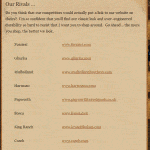No budget, no time? This KISS online marketing guide gets your health club, health coaching or yoga business on track.
Online marketing is an engine with three essential components: your website, your email newsletter and your website’s search engine visibility.
Social media like Facebook and Instagram are supplemental tools. They’re usually most helpful in promoting conversations and community among the clients you already have. They’re least helpful in quickly and directly generating new business.
Your website
A successful wellness website begins with content that specifically addresses the concerns, anxieties, myths and misconceptions that hold potential clients back.
For example, if they incorrectly believe that healthy eating means they can never eat a steak again, they’re going to resist making dietary changes and weight loss. If they think exercise always leaves you in pain the next day, your fitness program won’t be very appealing.
Your website should also spell out obvious next steps – “calls to action” – so that it’s easy for potential clients to take action if and when they’re ready.
Examples of typical next steps include a free newsletter, a free consultation, an invitation to a free webinar or in-person seminar, and time-limited enrollment offers.
Many wellness businesses promote price discounts like “Save 30% when you enroll by May 31!” on their websites in the hope that it’ll attract new clients.
Remember, however, that price and program details are completely irrelevant until a potential client has overcome all those initial concerns, myths, misconceptions and anxieties. And that’s the content that usually gets the least attention on your website!
Your email newsletter
Email newsletters give you control over the tempo and content of communication with potential clients.
What many wellness businesses don’t realize is that site visitors generally aren’t ready to make an appointment or enroll in a program on their first visit to your website. They look around a bit, and then move on. In a matter of minutes, you’re just a distant memory. At some point in the future, they’ll be ready to make a lifestyle change. But by then, they’ve completely forgotten you exist.
So the key is to find a way to stay top of mind with those site visitors, so that you’re the first wellness business they think of when they’re ready to move forward.
Your goal should be to persuade every single website visitor to sign up for your email newsletter. Use techniques like these: an appealing sign-up invitation, a short and sweet description of the kind of content they’ll get, a testimonial from a reader about how great the newsletter is, an immediate and truly valuable freebie when they sign up, like a downloadable hints and helpers list.
The newsletter keeps you top of mind until they’re ready to take the next step, rather than waiting passively in the hope that they’ll remember you and come back some day.
Best of all, your email newsletter serves the same purpose for people who find your business offline. For example, when you have a booth at a women’s expo or conduct a public seminar, your goal should be to get an email address for every single person who stops by your booth or attends your presentation.
Search engine visibility
Site content is the most important component of search engine visibility that you can influence.
Optimize your site for two dimensions:
1) key phrases that help you site show up in search engine results for a specific topic
A quick starting point is simply to search in Google for variations on your topic and see which searches get the most results. That’s usually a good indicator for how real people actually search for your service.
For example, “how to help my child lose weight” gets 33 million results. “Childhood obesity” gets 11 million results. Which one would your prospective client really be likely to search for?
The free Keywords tool in Google AdWords is another great tool for identifying the words and phrases your customers are most likely to use when they search for services like yours.
2) information that helps your business appear in local search results
If your focus is overweight kids, and you’re in Dallas, you want your business to be at the top of the results when someone searches for “kids weight loss Dallas.”
These four steps help your local search results:
- Include your full address with zip and your full phone number with area code on every page of your site.
- Display your address and phone information as text, not embedded in .jpg, .png or other image.
- Claim your Google, Bing and Yelp business listings and fully complete the business profile.
- Encourage your current clients to complete online Google, Bing, Facebook and Yelp reviews of your business throughout the year.


